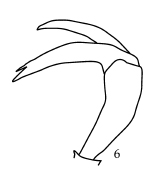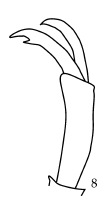
| 1. Meso- and metatarsal claws simple ........................................................... 2 1'. Meso- and metatarsal claws thickened and bifurcate or with ventral tooth (e.g., Figs. 6–8) ......................................................................................... 3
|
||||||
| 2. Tarsomere 5 with ventromedial tooth (Fig. 7) ............ A. pygidialis Ohaus 2'. Tarsomere 5 without ventromedial tooth (e.g., Figs. 6 and 8) ............................................................................... A. castaneus (Laporte)
|
||||||
| 3. Tarsomere 5 with ventromedial tooth (e.g., Fig. 7) ..... A. valdiviensis Smith 3'. Tarsomere 5 without ventromedial tooth (e.g., Figs. 6 and 8) .................... 4
|
||||||
| 4. Dorsally bicolored with brown head, elytron; pronotum with greenish reflections.
Pronotum with long, conspicuous setae in apical half. Antennal club elongated in males, longer than other segments combined, equal to or slightly shorter than head length (Fig. 4) .................. A. aconcaguensis Smith 4'. Dorsally with uniform or bicolored appearance. If bicolored then pronotum without conspicuous setae. Antennal club not elongated, equal to or shorter than other segments combined, much shorter than head length (similar to Fig. 5) ..................................................................................................... 5
|
||||||
| 5. Dorsal color dark or olive green ............................................................ 6 5'. Dorsal color brown (pronotum sometimes with greenish reflections) ........ 7 |
||||||
| 6. Maxillary palpus greatly enlarged in males, similar in size to antennal club (Fig. 5). Body length 11.7–16.3 mm. Dorsal color olive green. Pronotum and head not noticeably setose when viewed without magnification ........................................................................ A. viridis Guérin-Méneville 6'. Maxillary palpus not greatly enlarged, distinctly smaller than antennal club (similar to Fig. 4). Body length 15.5–17.3 mm. Dorsal color dark green. Pronotum and head noticeably setose when viewed without magnification .................................................................................... A. clypealis Ohaus
|
||||||
| 7. Pronotum with strong greenish reflections, moderately punctate, sparsely setose. Elytron rugose ....................... A. punctatus (Fairmaire and Germain) 7'. Pronotum without greenish reflections (weak greenish reflections in some individuals), densely punctate, moderately to densely setose. Elytron punctate to weakly rugose ...................................................................................... 8 |
||||||
| 8. Dorsal color reddish-brown to dark brown. Maxillary palpus only slightly elongated, length shorter than eye diameter; widest near base. West of Andes Mountains from Coquimbo to Malleco, Chile ............. A. ciliatus (Solier) 8'. Dorsal color yellowish-brown to brown. Maxillary palpus noticeably elongated, length subequal to eye diameter; usually widest near middle. Generally east of Andes Mountains from Neuquén to Santa Cruz, Argentina (but also found in eastern Malleco, Chile) and the southern tip of South America (Aisén and Magallanes, Chile and Tierra del Fuego) ..................... A. pilicollis (Fairmaire) |
||||||
| Remarks on Identification. Additional diagnostic characters can be found in the species pages (click on the underlined species names). Male genitalic characters can also be used as an identification aid. The parameres of A. castaneus, A. punctatus, and A. viridis are unequivocal. The parameres of Aulacopalpus pygidialis and A. valdiviensis are distinct from the other species of Aulacopalpus but virtually identical to each other. Although the parameres of A. aconcaguensis, A. ciliatus, A. clypealis, and A. pilicollis are distinct from the other species in the genus, there is great interspecific variation in the form. Other features must also be used to reliable identify these four species. |
||||||
Author: Andrew Smith (
Canadian Museum of Nature) |




